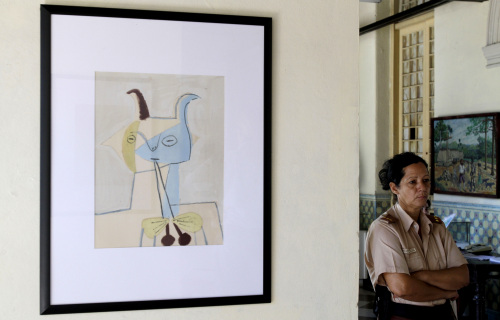PINAR DEL RIO, Cuba (AP) ― A traveling exhibition of art donated by a U.S. philanthropist is giving Cubans outside the capital a rare chance to see works from masters such as Pablo Picasso and Andy Warhol that would normally hang in world-class galleries instead of sleepy provincial cities.
Selections from the 120-piece collection have already toured Camaguey and Holguin in the island’s far-flung east and recently went on display in the western city of Pinar del Rio, known more for tobacco farms than art museums.
More than a dozen works by Joan Miro, Marcel Duchamp, Camille Pissarro, Georges Rouault, Roy Lichtenstein and others went up in the glassed lobby of a local TV station, watched over by just a few police and guards and prompting curious passers-by to pop in to see what all the fuss was about.
The showcase of the exhibit was a few blocks up the street at the Provincial Museum: 12 lithographs created by Picasso in a 1959 series called “Faunes et Flore d’Antibes,” depicting grinning, horned satyrs with flowers and playing flutes.
Selections from the 120-piece collection have already toured Camaguey and Holguin in the island’s far-flung east and recently went on display in the western city of Pinar del Rio, known more for tobacco farms than art museums.
More than a dozen works by Joan Miro, Marcel Duchamp, Camille Pissarro, Georges Rouault, Roy Lichtenstein and others went up in the glassed lobby of a local TV station, watched over by just a few police and guards and prompting curious passers-by to pop in to see what all the fuss was about.
The showcase of the exhibit was a few blocks up the street at the Provincial Museum: 12 lithographs created by Picasso in a 1959 series called “Faunes et Flore d’Antibes,” depicting grinning, horned satyrs with flowers and playing flutes.

“This is a very important thing for the people of Pinar del Rio and even for my institution, to have works from such accomplished figures,” said museum director Maria de las Nieves Ramos. “We treasure culture ... but don’t usually have the possibility to see such works displayed in one of our institutions.”
More than 700 people turned out for the opening last week, and a steady stream of school groups, art students and other Pinarenos has been stopping in for what seems a once-in-a-lifetime opportunity to see such works without trekking to the capital.
“The first reaction is for people to say, ‘Are they really originals?’” de las Nieves said. “Because sometimes we couldn’t believe that original works by Picasso would be in our institution, on display in our province.”
Yordanka Marti, a Pinar del Rio museum employee who was in charge of the show at the TV station, said locals are more used to realistic landscapes and other more traditional movements than to the modern, abstract images on display.
Since the 1959 revolution, Cuba has placed a high value on culture and devotes significant resources to dance, theater, music and other fine arts. Philanthropist Gilbert Brownstone, a dual American and Swiss citizen who has had close ties to Cuba over the years, cited the island’s cultural development as inspiration for his foundation’s permanent donation.
“I can say without hesitation that the Cuban people is one of the most prepared in the world to appreciate any form of art,” he said in an essay in the show catalog.
The show was nearing the end of its tour as officials prepared this week to dismantle it and return the works to Havana.



















